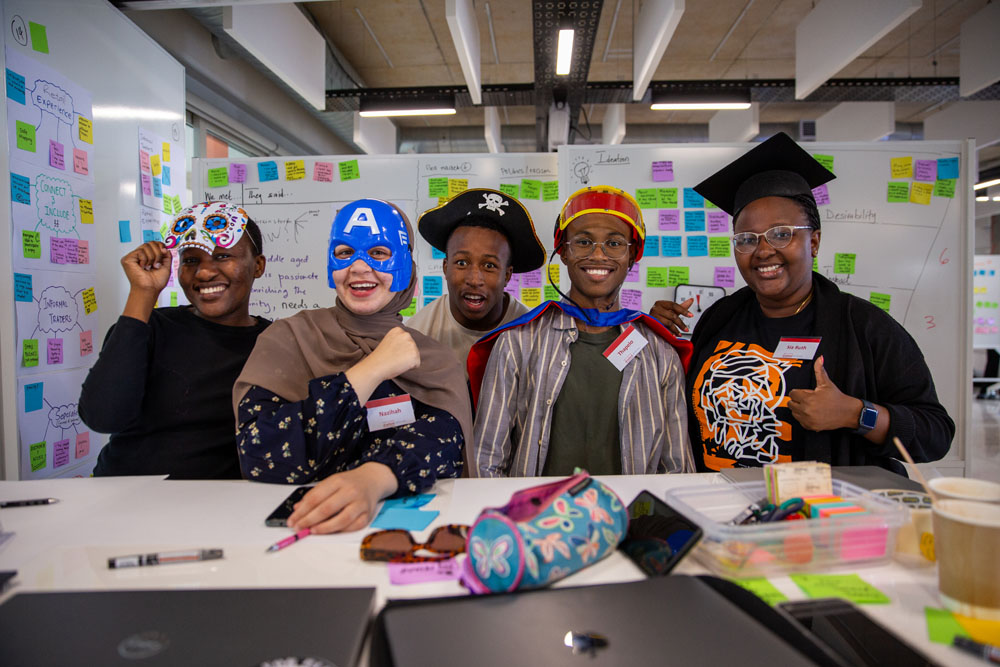You can’t generate original solutions using the same well-worn routes of problem solving. Different results demand new pathways – alternative ways of collaboration and ideation that get people thinking and moving differently. Some design thinking champions are embedding design thinking in company culture through games and exercises that have people practising out-of-the-box solution exploration.
Some are putting their own design thinking values to the test, practising deeper listening in their commitment to developing human-centric technologies. And others are cross-examining design thinking as a theory and practice, applying a critical lens make sure it is delivering on its promise of tackling our most complex problems. In four different sessions, change-makers share lessons from their experiences of putting design thinking to the test out in the world.
Serious design at play
Launchlabs is a global entrepreneurial development platform that embeds design thinking into its coaching and mentoring curricula, but it does this in a playful, off-kilter way. In a breakaway session, Launchlabs facilitators hosted a game that challenged participants to reach a defined endpoint on a board – but without the safety and structure of prescribed rules. Instead of mastering a single skill and progressing down a linear path, teams worked together to interpret the rules as the game evolved. Completing tasks and advancing meant practicing cross-functional teamwork, customer focus, innovation culture and experimental mindset – principles inherent in taking a design thinking approach.
Innovating agriculture and entrepreneurship
In their effort to apply research to real-life challenges, the D-School at the Universidad Mayor in Chile stretched their own out-of-the-box approaches. The programme set out to use design thinking methodology to help equip 20 entrepreneurial rural farmers with business and financial planning skills and train problem-solving methods for their equipment challenges. Then Covid-19 stuck and the project planners had to rethink their training approach. Instead of face-to-face encounters, they created videos and design booklets with information; they used radio stations and local municipalities extend their reach. Ultimately, the impact of the project spread beyond its original scope.
Global youth designing for mental wellness
The World Design Organisation’s Young Designers Circle (YDC) harnesses the creativity and ambition of young designers across multiple disciplines and regions to design for a better world. Since 2020, the programme’s objective has been to promote the use of design to meet the United Nations Sustainable Development Goals (UN SDGs). The team uses jam board bringing online and in-person delegates together to explore how design thinking can be a catalyst for innovation in healthcare. They aim to develop a human-centric and empathetic approach to help destigmatise mental health and promote well-being for all (SDG 2). “We can co-create thriving conditions for better mental healthcare that’s not only science-based and techno-centric but also rooted in alternative ways, such as indigenous knowledge systems and cross-cultural contexts,” said Corbin Raymond, Industrial Designer and inaugural 2019-21 YDC designer. “This requires a deeper sense of understanding and engaging with human-centric approaches.”
Design thinking report card
Pulling back from the notion of design thinking as a blanket panacea, some critical voices are working to keep design thinkers accountable to their own ideals. GK VanPatter, author of Rethinking Design Thinking and co-founder of Humantific, a New York-based consultancy, is asking: is design thinking really offering sense-making methods for change-making in a complex world? “In traditional design thinking, the methodology doesn’t quite match up to its philosophy’s promise,” said VanPatter. “There is a glaring disconnect between the two.” Examining four challenge arenas he identifies in his book, VanPatter showed that in 2019 approximately 90% of design thinking methods were operating in small-to-medium scale arenas, with visual, product, service and experience design challenges.. “With the vast majority of the design community focused there,” he observed, “most of the graduate programmes are as well. We see very few graduates coming out of postgraduate design schools with upstream skills.” The next generation of emerging practice is evolving towards large-scale challenges in organisations, systems and industries, and even more for the complexity of giant-scale challenges at the level of communities, countries and the planet.
Stretching the limits
Whether they’re academics, app-developers, youth designers, farmers or futurists, communities of design thinking practitioners are defining, teaching and evolving what design thinking is and what problems its champions are brave enough to tackle. Former YDC designer turned educator, Ralitsa Diana Debrah, put it perfectly: “We’ve been using design thinking as an enabler, tool, mindset and culture to design innovative solutions from a grassroots level in local communities with global impact.” With empathy, human-centricity and collaboration, shaping its processes, the hope is that the results will be radically transformative for society. But, it’s easy to default into old ways so design thinkers must be also be honest and vigilant about addressing the methodology’s weak points. As VanPatter acknowledged, “Historically, design has been exclusive. To change this, design has to become more inclusive and cognitively diverse.”




